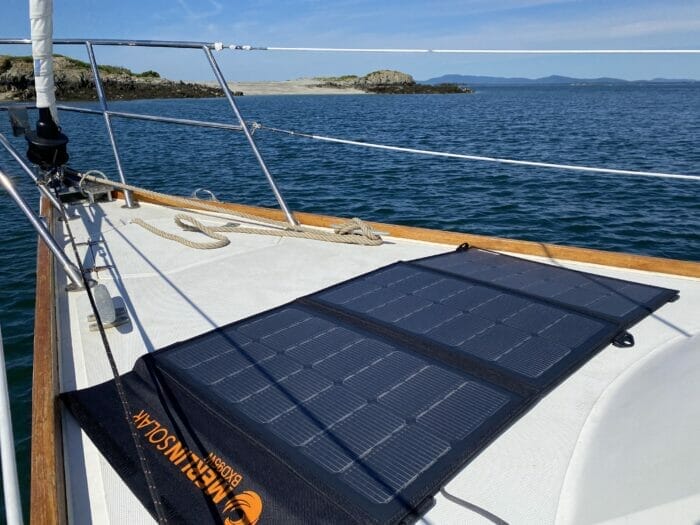
The good folks over at Ocean Planet Energy are selling these foldable and portable solar panels.
A couple of these will provide a cruising boat with around 100 amp hours at 12 volts over the course of a reasonably sunny day at anchor.
To me this is a way better idea, at least to supplement a reasonable number of fixed panels, a good cruiser’s alternator, and possibly a hydro-generator for offshore use, than festooning a boat with a huge unseamanlike fixed solar array.
Might even get one of these for our J/109, and I also think this, or something like it, could be a great solution for many Adventure 40 owners.
Update January 2025
Member Terence bought these panels and reports that they are not waterproof, or even water resistant. Maybe not a deal breaker, but it does make this a more attractive option.

Our 150 watt panel, installed horizontally above the Bimini with no shade, give us a maximum of 30 Amp-hours per day here at 15 deg North
Hi Neil,
Thanks for the real world numbers. I did wonder if that estimate of total Ah was a bit optimistic. That said, surely your panel will get some shading from the mast and backstay over the course of the day? Also those portable panels can be inclined to the sun, which might help them a bit. On the other hand they will get some shading too, so probably a wash.
Anyway, the key, and valuable, point you make that the difference between theoretical output and actual over a day is huge.
Hi Neil,
I am a little surprised by how low an output you are recording unless you only cruise in the short days of winter, you are 24V or something. We have an older Kyocera 140W panel with ±30° manual tilting capability through a Victron MPPT controller and on normal sunny summer days average around 60 Ah at 12V nominal and have peaked a little over 70 Ah in a single day near the summer solstice. We are located at 42N so on average should have less solar potential than you.
Have you read the max current coming from the panel on a perfectly clear sunny day with the sun directly overhead? If you are not seeing right around the panel’s rating, then something is wrong. A tiny bit of shading such as a backstay can provide a shocking drop in output and I know several people who have thought there was a panel problem when instead they had something like a spare halyard tied off in a bad way. Since you mention the panel is above the bimini, if it is a flexible panel and has been flexed too much, it may well be damaged and not really putting out. One other thought is that there are plenty of apps and online calculators that let you plug in all your parameters and they pull the climate data and give you a predicted output assuming you are not load limited so you could check one of those against your real world numbers.
Eric
Why would you not install a semi-flexible panel in the same location? I bet lunch it produces more power because it will be exposed for 3 times more hours, because you don’t have to fool with it or forget to put it out.
Yup, I like hard panels, but unless you have a big hardtop (cruising cats) using deck space with semi-flexible panels makes a lot of sense. I installed a semi-flexible panel on the companionway turtle several years ago, and while it sees some shading, it is there, making power, all day. I would also bet it will last as long because it will see less flexing and handling (flexing is the leading cause of death of Bimini panels–micro cracking of the cells).
Hi Drew,
A bunch of reasons, but the main reason is that I do not consider the semi flexible panels, even those that claim non-skid to provide safe footing, therefore I believe they should be limited to very low traffic areas, and certainly not be used on, for example, the foredeck.
Other benefits of the portable are easy installation, being able to incline it, being able to move it to a better place to avoid shading, and air space underneath which will enhance cooling and up efficiency.
So I can see a use for these, although I agree that semi flexible have used too.
Do you have a recommendation connecting these folding panels to your house banks for charging? Especially if you might want to move them to different locations throughout the day?
We have one that’s used to charge our electric outboard battery and laptops but I couldn’t figure out a reasonable way to direct the power to the house bank. Likely I’m missing something obvious and would love a hint!
Hi Charlie,
This was just a tip about an interesting option, so I have not put much thought into the details. Seems like you could have a waterproof plug and socket around amidships and the use a wandering lead to connect the panel to it. Just make sure the wire is a heavy enough gauge to carry the current without undue voltage drop.
I installed a Victron 75-15 MPPT solar charge controller and wired it to my house bank. Straight forward. The extension cord I bought with the Merlin plugs into the controller and into the array. Bought everything at a good price from 4thD Solar in Ohio. All on the web and products shipped promptly. They will tell you what you need.
I bought a Merlin folding 170 watt array after you wrote about it. I don’t know what the backing is and nether does the sales manager, but it may be impregnated cardboard. They say not to get it wet. But the device is great for when at anchor in the sun. I sat for a week here in Mexico using my 200 watt array above the bimini and the Merlin 170 watts. I made water for several hours and my refrigerator ran too. The batteries stayed where they started. And it is very easy to fold and store in the forecastle. Haven’t tried deploying it underway. Conditions would have to be pretty mild, I fear. So I still cannot keep up with electricity demand offshore, except with an occasional engine run (at load, of course.)
Let me add to my experience with the Merlin portable solar panels. I have a 170 watt array that consists of three panels that fold over each other for storage. They appear to be better than their ignorant sales manager told me.(He was the guy that did not even know what material the actual solar cells are mounted on.) He also warned about “leaving them in the rain,” as I reported earlier. Well, necessity led to a test of that warning.
My son and I just completed a 30 day, 3500 mile voyage from Puerto Vallarta to Astoria, Oregon. We rarely ran radar, but did run our other instruments, LED lights, and the refrigerator. (The OzeFridge holding plate system is fairly efficient, but draws about 9 (12V) amps when running.) We have an older solar array of 200 watts over the stern of the boat. We also have the 170 watt Merlin folding array, whose solar cells, I believe, are more efficient than those on the old array.
Anyway, given limited fuel capacity and plenty of wind, we did not want to run the engine just to charge batteries. And I knew from experience that unless sun conditions were perfect, the old array would not keep up with the load. Battery capacity would drop as the days passed. So, I just tied the Merlin down to the starboard side of the cabin top (and handled main management–reefing, striking, raising, etc– from the port side). With both solar arrays, even on less than fully sunny days, with the exception of a couple of days of thick fog, our 500 amp hours of lead acid batteries were full every day, often before the end the afternoon. We essentially ran most of the time for 30 days with battery capacity between 90 and 100%.
Most tellingly for this discussion, the Merlin array was repeatedly inundated with saltwater and was jostled and banged around by boarding waves. We sailed the so-called “clipper route,” basically a big boomerang track, out into the Pacific (700 miles off the Northern California coast) and then back into the British Columbia coast and down to Astoria. The winds varied, but were regularly sufficient to create boisterous seas that poured over the forward half of the boat and tore at the lashings holding down the Merlin array. (The trip was often bumpy, but not dangerous.) The array never stopped working whenever the sun shone, even when the array was partially shaded by the mainsail. The platform frame (of undetermined composition) on which the thin solar panels are glued, shows no deterioration, at least thus far, a month after we got home to Oregon.
Merlin no longer makes the 170 watt array, but some retailers still offer them for sale. They are best for lying at anchor, of course, and I used them so while in Mexico this last winter. But they seem to be quite robustly made, as well. There are probably other brands of the same type of portable solar. I just happened to buy the Merlin after John mentioned them in one of his posts. Thanks for yet another helpful tip John
Hi Terence,
Wow, what a great report, and super useful, thank you! There is just nothing better than this kind of real world reporting from a real and challenging offshore passage, particularly these days when there is so much pure BS circulating.